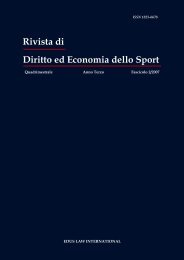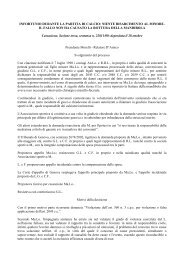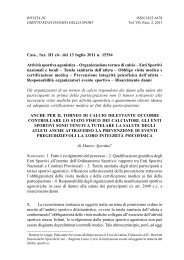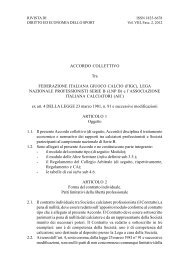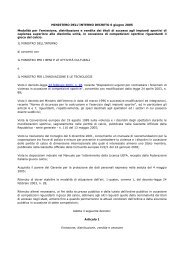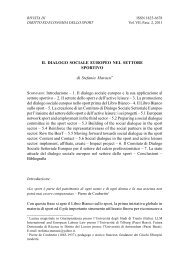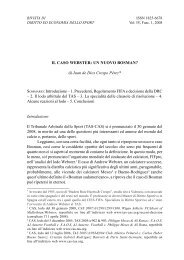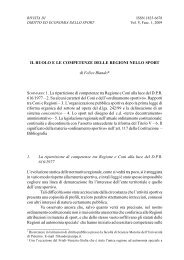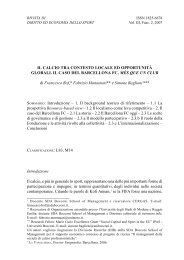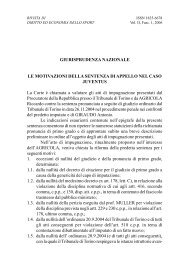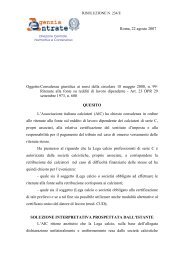Create successful ePaper yourself
Turn your PDF publications into a flip-book with our unique Google optimized e-Paper software.
Globalization of the sports economy 27<br />
rationing organized by a closed league are: (1) some rival leagues had emerged, at<br />
least for some time, in all American professional sports; (2) each time a league<br />
opens a new expansion franchise, a great number of potential candidates are queuing<br />
to enter; (3) leagues and clubs are capable of price discrimination among spectators<br />
w<strong>it</strong>hout loosing attendance. The regulation of the league is not countervailed by<br />
compet<strong>it</strong>ive threat of a takeover via financial markets, as in other American<br />
industries, since American teams are not listed in the stock exchange. They are not<br />
exposed to hostile (or even friendly) acquis<strong>it</strong>ions, mergers or raiders.<br />
The closed league monopoly power in <strong>it</strong>s product market is augmented<br />
w<strong>it</strong>h a monopsony power in <strong>it</strong>s major input (labour) market. In the 1970s, veteran<br />
players obtained, after a number of strikes, the status of free agents. Coupled w<strong>it</strong>h<br />
a high rate of player unionization, this evolution tended to fuel wage inflation. In<br />
order to curb wage inflation, a salary cap was introduced in National Basketball<br />
Association and National Football League. A maximum payroll is fixed through<br />
collective bargaining between owners and player trade unions as a given percentage<br />
of overall league revenues that accrues to players. Dividing the league payroll<br />
across teams, the maximum payroll is fixed for each team. Thus, all teams must<br />
adjust by e<strong>it</strong>her handling payrolls or adapting the number of players (namely<br />
superstars) downwards. Such a rule is supposed to prevent the richer teams from<br />
“grabbing” all the best players and deteriorating too much the league’s compet<strong>it</strong>ive<br />
balance.<br />
Another regulation, the rookie draft, is entirely devoted to maintaining a<br />
balanced compet<strong>it</strong>ion. The rules of the draft system prohib<strong>it</strong> the entrance in major<br />
league of new young players (rookies) and players from college teams, minor leagues<br />
or from abroad. Players are ranked by experts on a draft according to their past<br />
sporting performances (an assessment of their talents). It is a reverse-order-offinish<br />
draft. 34 The team which has been the last ranked at end of the past<br />
championship has a prior<strong>it</strong>y choice for players to be hired (thus this team is supposed<br />
to choose the best player) while the past season’s champion is the last team to<br />
choose and hire a player ranked down the draft (supposedly one of the weakest<br />
player). Obviously, this rule has been designed to maintain compet<strong>it</strong>ive balance<br />
but <strong>it</strong> also spreads the league monopsony power to all players who have not even<br />
signed a first time w<strong>it</strong>h a professional team before. Finally, an American sport<br />
league is regulated through revenue sharing which reduces the gap between big<br />
rich and poor small teams in terms of gate receipts and broadcasting rights. In a<br />
nutshell, a closed league is an exception to the liberal and compet<strong>it</strong>ive credo w<strong>it</strong>hin<br />
American cap<strong>it</strong>alism.<br />
However, a closed league does not forbid and does not really hinder<br />
international mobil<strong>it</strong>y of players. On the other hand, <strong>it</strong> is not open to international<br />
team mobil<strong>it</strong>y. North American teams which had won the major league baseball<br />
championship never confronted afterwards non-American teams in an international<br />
____________________<br />
34<br />
L.H. KAHANE, The reverse-order-of-finish draft in sport, in W. Andreff, S. Szymanski, (eds.),<br />
Handbook on the Economics of Sports, c<strong>it</strong>., 643-45.



